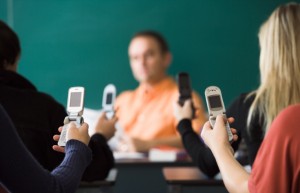- 88% of kids with cellphones use them to text
-83% use them to take pictures and 64% to exchange pictures
-54% to record and 32% to exchange video
- 27% to trawl the web
-23% to post to social networking sites
Using these devices, kids are building a complex and innovative new communication ecology, and if we examine it through the right lens, we might see a world of learning and learning possibilities to tap into.
And yet, consider the above in light of these numbers below:
- 24% of teens attend schools that ban all cell phones from school grounds
- 62% of all students say they can have their phone in school – just not in class
- Only 12% of all students say they can have their phone at school at any time (although we don't know if they can use them)
Looking across the generational divide, we see kids using their devices in innovative ways to learn, connect, ask questions and look for answers. Their learning is self-motivated, led by a desire to know. It bears little in resemblance to the artificial learning styles used in traditional schools. These kids might not even call what they’re doing learning—they’re just interested in the topic and are using the tools at their disposal to explore and investigate: powerful mobile mini-computers—their cellphones—enable them to inquire and then reflect, document, communicate what they find. It's mobile learning, or mlearning for short. It's anywhere, anytime learning by choice and defined by interest.
Many of our public schools, especially in hard-hit urban centers, are in crisis. High school dropout rates hover between 40-50% for low-income and students of color, and college seems a dream deferred. Yet surveys show that minority teens, especially African Americans, from low-income households, are much more likely than other teens to go online using a cell phone. It's a familiar tool that could open up a world of learning, and rather than embracing them and teaching to their potential, we ban and confiscate them. In doing so, we make outlaws of learners who bring them to school.
That's the real crime.


